Tuesday, 9 June 2009, Troyes to Dijon
Written 10 June 2009
Tuesday morning, David slept late (but not until noon, as he had the day before), then as agreed the day before, before leaving Troyes, we set out to explore the Museum of the Tool. It was almost check-out time, so we vacated the room, but the hotel (the Hôtel de Troyes on Ave. LeClerc) agreed to mind our luggage for us, so that we wouldn't have to leave it in the car all morning. We brought along our rain jackets, because it was a little cool and looked a bit rainy. I had to keep my Tilley hat strapped on because of the stiff breeze. "Tilleuls" (linden trees) were blooming in the parking lot and smelled delicious (the museum does not have its own parking, of course—nothing does in these tightly packed little Medieval towns—this was another of the little tree-lined gravel lots around the perimeter of the downtown.
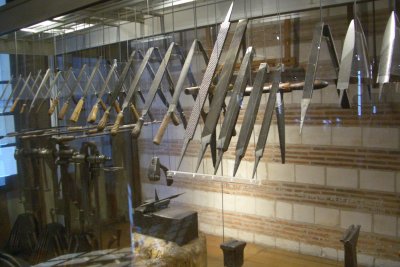
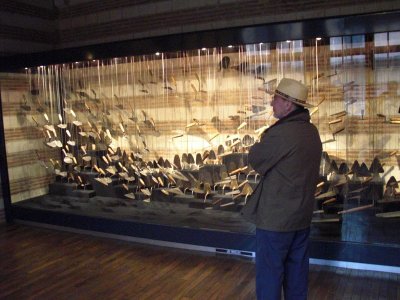 The museum was, as promised, astonishing. It started with a case full of nothing but "limes" (files) and "râpes" (rasps), shown here at the left—I don't know the difference between files and rasps; perhaps files have groves but rasps have teeth? Gotta look that one up. Next was a whole case full of tools forged from worn-out files and rasps (you couldn't waste the iron), everything from chisels to wrenches, to rulers, to pincers, to knives. Sometimes, where they didn't interfere with the new use, you could see the residual grooves and teeth. I had always thought of files and chisels as rather "incidental" tools—less important than, say, hammers and saws—but this exhibit made clear that they were often the first use of "new" iron, a sort of larval stage that many other tools passed through. Unfortunately, it was all very difficult to photograph, partly because the glass reflected the lights, the camera, the photographer, and other cases and tools in the room and partly because all the cases were double-sided and free-standing, so the tools were never displayed against a plain background.
The museum was, as promised, astonishing. It started with a case full of nothing but "limes" (files) and "râpes" (rasps), shown here at the left—I don't know the difference between files and rasps; perhaps files have groves but rasps have teeth? Gotta look that one up. Next was a whole case full of tools forged from worn-out files and rasps (you couldn't waste the iron), everything from chisels to wrenches, to rulers, to pincers, to knives. Sometimes, where they didn't interfere with the new use, you could see the residual grooves and teeth. I had always thought of files and chisels as rather "incidental" tools—less important than, say, hammers and saws—but this exhibit made clear that they were often the first use of "new" iron, a sort of larval stage that many other tools passed through. Unfortunately, it was all very difficult to photograph, partly because the glass reflected the lights, the camera, the photographer, and other cases and tools in the room and partly because all the cases were double-sided and free-standing, so the tools were never displayed against a plain background.
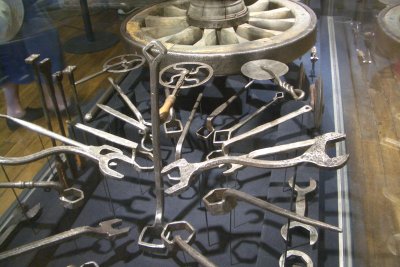
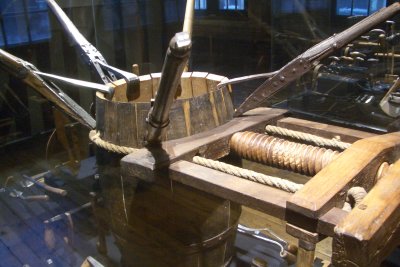 Room after room was filled with cases, carefully arranged and labeled (at the front desk, they gave us a book to carry around that translated some, but not all, of the labels; of course, I often didn't know the English word any better than the French), of tools of different kinds—trowels, shown above at the right, arranged according to different uses), vises, pincers, chisels, hammers, axes, adzes, picks, shovels, drills, awls, anvils, planes, etc.—or according to different trades—farriers and blacksmiths (on the front of the case was a quote saying, "As the smith forges the iron, he forges himself into a smith."), wheelwrights, coopers, glovemakers, bookbinders, masons, pavers, roofers and slate-splitters, tilers, brick makers, carpenters and joiners, plasterers, basket makers, stuccoers, plumbers, etc. Interspersed among the tools in the cases were little metal apron clips, used to secure workers' leatheraprons and often fashioned to depict the worker's trade. You could spend days in there, studying the variations in tools, figuring out how each one was used, deducing why some hammers had straight handles and some curved handles, why the bookbinder needed so many different sizes and shapes of creasing tools, why the blade of a cooper's axe was set at an angle to the handle. Fascinating!
Room after room was filled with cases, carefully arranged and labeled (at the front desk, they gave us a book to carry around that translated some, but not all, of the labels; of course, I often didn't know the English word any better than the French), of tools of different kinds—trowels, shown above at the right, arranged according to different uses), vises, pincers, chisels, hammers, axes, adzes, picks, shovels, drills, awls, anvils, planes, etc.—or according to different trades—farriers and blacksmiths (on the front of the case was a quote saying, "As the smith forges the iron, he forges himself into a smith."), wheelwrights, coopers, glovemakers, bookbinders, masons, pavers, roofers and slate-splitters, tilers, brick makers, carpenters and joiners, plasterers, basket makers, stuccoers, plumbers, etc. Interspersed among the tools in the cases were little metal apron clips, used to secure workers' leatheraprons and often fashioned to depict the worker's trade. You could spend days in there, studying the variations in tools, figuring out how each one was used, deducing why some hammers had straight handles and some curved handles, why the bookbinder needed so many different sizes and shapes of creasing tools, why the blade of a cooper's axe was set at an angle to the handle. Fascinating!
Several video screens were showing craftsmen at work, especially blacksmiths. I was especially fascinated by a water-wheel-driven hammer. A metal block, perhaps the size of a brick, that served as the hammer's face was fixed into a heavily weighted wooden chuck at the end of a long wooden lever, and wooden wedges were hammered in to hold it in place (the chuck and lever were made of pieces of wood that could have been used as railroad ties). When the smith pressed a peddle that allowed water to flow over a huge water wheel and start it turning, it drove a gear, each tooth of which pressed down on the other end of the lever, momentarily lifting the hammer head a few inches, then letting it fall heavily back into place on the anvil as that tooth passed, only to be lifted again by the next tooth. As a result, the hammer head rose and fell, with frightening force, a couple of times a second. The smith then pulled a piece of hot iron out of the fire, shoved it under the hammer head, and moved it around—as I would move fabric around under the presser foot of a sewing machine—as it was pounded flat and into the desired shape. In the video, he seemed to be making machete blades. As he finished each one, he stepped on a second pedal to stop the flow of water and still the hammer. Wow.
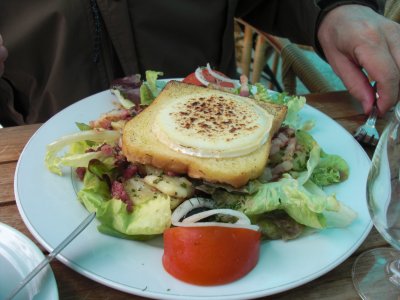
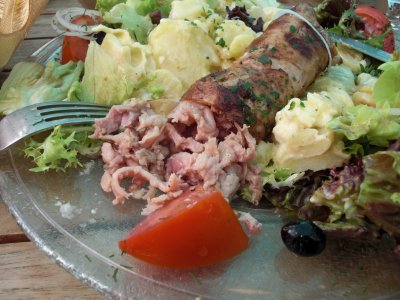 Alas, our feet got tired, and we got hungry, and we had yet to drive to Dijon, so we left the museum to look for lunch, which we found at Maxime's (no, not the famous one), just a few doors away. David had a salad topped with sautéed potatoes, lardons, a slice of toast, and a round of grilled Chource cheese. My salad was topped with "Chaource potatoes" (cooked potatoes that had been layered with Chource and cream and baked until it all melted together) and an entire andouillette. I show it here after I'd cut into the andouuilette, to demonstrate the consistency of the filling. It's cut rather coarsely, so it's identity as tripe is not sufficiently disguised for some tastes. I love it.
Alas, our feet got tired, and we got hungry, and we had yet to drive to Dijon, so we left the museum to look for lunch, which we found at Maxime's (no, not the famous one), just a few doors away. David had a salad topped with sautéed potatoes, lardons, a slice of toast, and a round of grilled Chource cheese. My salad was topped with "Chaource potatoes" (cooked potatoes that had been layered with Chource and cream and baked until it all melted together) and an entire andouillette. I show it here after I'd cut into the andouuilette, to demonstrate the consistency of the filling. It's cut rather coarsely, so it's identity as tripe is not sufficiently disguised for some tastes. I love it.
Writen 11 June 2009
The rain started as we got back to the car, and we jumped inside just in time to avoid the cloudburst. The rain then obligingly paused, back at the hotel, while we loaded our luggage and got out of Troyes, but we drove through scattered showers all the way to Dijon. We had not yet managed to acquire a roadmap of the region, so we were working from my Google (actually Mappy) maps of Troyes and Dijon and trusting to the road-sign people to get us from one to the other (about 2.5 hours). Obligingly, they offered two choices: Dijon via the superhighway (with toll) and Dijon via the old road (no toll). We chose the latter and, as we had hoped, found it to be much more scenic. The country was open and rolling, so we could see distant localized showers as well as the few that passed over us. In addition to the usual crops, we saw one series of fields of what I took to be lentils, in the pod but still green. I also saw a line of modern windmills turning lazily in the distance. They were clearly gigantic, but they were sited so as to be quite unobtrusive, just sticking their heads up over the ridge to catch the wind.
As we approached Dijon, I found that my little map didn't show the route number on which we were approaching the city, but I hypothesized which radial road we were likely to be coming in on. A few miles out, though, we passed a small airport at the junction with route D104, which was signposted to Prenois—That rings a bell!, I thought, studying the pencilled notes in the margin of my map. Sure enough, that was the turn to our Thursday-night restaurant ("Turn left on the D104 at the small airport."), so my hypothesis was confirmed. From there it seemed like a simple matter to reach our hotel, but of course the one-way streets (not marked on my map) got us, so it took a little maneuvering, but we managed to get there in two tries. Just in time, as it turns out—by the time we checked in and got our luggage up to the room, wind-driven pea-sized hail was rattling on the windows.
Our hotel is the Ibis Arquebuse Dijon (part of the Accor chain). An "arquebuse" is a sort of primitive firearm, similar, if not identical, to a blunderbuss. I'm sure there's a good historical reason why our hotel, the adjoining public garden, and this whole neighborhood are called "Arquebuse," but I don't know it. Surprisingly, the hotel offers free WiFi—that's two in a row; I hope it's the new trend. You just present yourself at the desk (they won't give the access codes over the phone) and are given a sheet with a user ID and password that are good for 24 hours after you first use them. You have to get a new one each day. The more centrally located Mercure and Ibis were booked for our dates, so we're a little outside the middle of things, but not very far.
After unpacking and taking it easy for a while, we set off on foot for our restaurant of the evening, the Bistrot du Marché, ranked just GM 13/20. I think it's the downscale branch of a more upscale restaurant (maybe the one in Prenois?), but I'll have to check that. Anyway, as the name would imply, it's right next to Dijon's huge covered market.
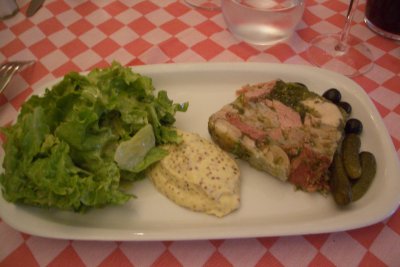
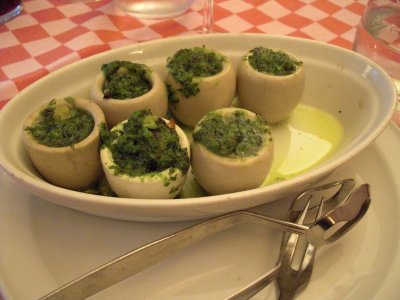 First course, David: Jambon persillé, a specialty of the region that David remembered very fondly from our time in Beane in 1977. It's a cold dish of chunks of ham embedded in an aspic dense with chopped parsley. This particular one supplemented the ham part with similarly embedded calf's foot. It was served with a mild, cold mustard cream sauce, very sour gherkins, black olives, and salad. David said the mustard in the salad dressing was much stronger than that in the sauce.
First course, David: Jambon persillé, a specialty of the region that David remembered very fondly from our time in Beane in 1977. It's a cold dish of chunks of ham embedded in an aspic dense with chopped parsley. This particular one supplemented the ham part with similarly embedded calf's foot. It was served with a mild, cold mustard cream sauce, very sour gherkins, black olives, and salad. David said the mustard in the salad dressing was much stronger than that in the sauce.
First course, me: Six Burgundy-style snails (that's the classic treatment with the garlic, butter, and herbs) baked, not in their shells, but in small, individual, ceramic snail pots—straight from the oven and blazing hot. The specially shaped snail tongs did not hold the pots as steadily as they would have actual snail shells, but with their help I was able to consume the snails and sop up all the good garlic butter with bits of bread.
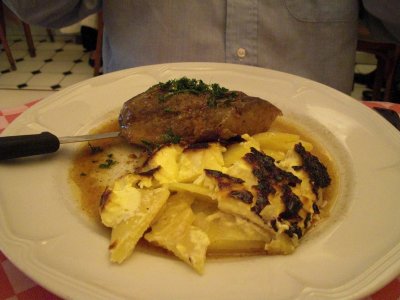
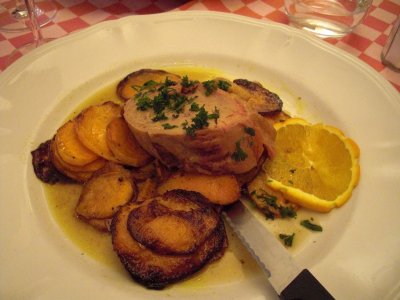 Second course, David: A leg of crisp-skinned, rotisserie-roasted guinea fowl, sided with the best gratin dauphinois (garlic-and-cream scalloped potatoes) we've ever tasted. Definitely a wow!
Second course, David: A leg of crisp-skinned, rotisserie-roasted guinea fowl, sided with the best gratin dauphinois (garlic-and-cream scalloped potatoes) we've ever tasted. Definitely a wow!
Second course, me: Braised "paleron" (shoulder pallette?) of veal, on a bed of sliced sweet potatoes baked in an orange sauce. The veal was beyond fork-tender—you could have eaten it with a spoon—and was utterly delicious (note that it even has a "smoke ring," the pink rim just under the surface of the meat, characteristic of slow, dry-cooked meat like Texas brisket). The sweet potatoes were great in their own right, as was the slice of roasted orange.
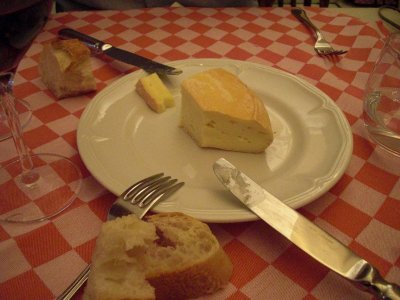
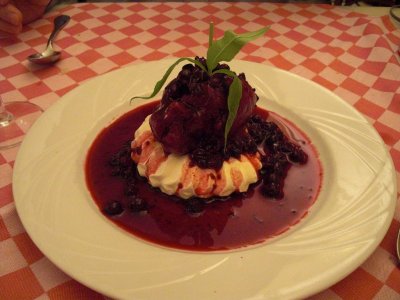 Cheese course: We split a serving of "Citeaux," which I think is made by the monks at a monastary in Gilly-les-Citeaux, where we'll be staying in a few days. It was similar to the cheeses of Normandy (camembert, pont l'éveque) but milder, and I liked it alot, David not so much.
Cheese course: We split a serving of "Citeaux," which I think is made by the monks at a monastary in Gilly-les-Citeaux, where we'll be staying in a few days. It was similar to the cheeses of Normandy (camembert, pont l'éveque) but milder, and I liked it alot, David not so much.
Dessert: On the waitress's recommendation we shared an order of "meringue glacé au cassis," a fluted disc of crisp meringue topped by a large scoop of black currant sorbet and a big spoonful of stewed black currants, garnished with a whorl of lemon-verbena leaves. Delicious.
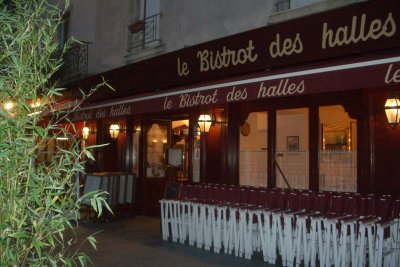
previous entry
List of Entries
next entry

 The museum was, as promised, astonishing. It started with a case full of nothing but "limes" (files) and "râpes" (rasps), shown here at the left—I don't know the difference between files and rasps; perhaps files have groves but rasps have teeth? Gotta look that one up. Next was a whole case full of tools forged from worn-out files and rasps (you couldn't waste the iron), everything from chisels to wrenches, to rulers, to pincers, to knives. Sometimes, where they didn't interfere with the new use, you could see the residual grooves and teeth. I had always thought of files and chisels as rather "incidental" tools—less important than, say, hammers and saws—but this exhibit made clear that they were often the first use of "new" iron, a sort of larval stage that many other tools passed through. Unfortunately, it was all very difficult to photograph, partly because the glass reflected the lights, the camera, the photographer, and other cases and tools in the room and partly because all the cases were double-sided and free-standing, so the tools were never displayed against a plain background.
The museum was, as promised, astonishing. It started with a case full of nothing but "limes" (files) and "râpes" (rasps), shown here at the left—I don't know the difference between files and rasps; perhaps files have groves but rasps have teeth? Gotta look that one up. Next was a whole case full of tools forged from worn-out files and rasps (you couldn't waste the iron), everything from chisels to wrenches, to rulers, to pincers, to knives. Sometimes, where they didn't interfere with the new use, you could see the residual grooves and teeth. I had always thought of files and chisels as rather "incidental" tools—less important than, say, hammers and saws—but this exhibit made clear that they were often the first use of "new" iron, a sort of larval stage that many other tools passed through. Unfortunately, it was all very difficult to photograph, partly because the glass reflected the lights, the camera, the photographer, and other cases and tools in the room and partly because all the cases were double-sided and free-standing, so the tools were never displayed against a plain background.
 Room after room was filled with cases, carefully arranged and labeled (at the front desk, they gave us a book to carry around that translated some, but not all, of the labels; of course, I often didn't know the English word any better than the French), of tools of different kinds—trowels, shown above at the right, arranged according to different uses), vises, pincers, chisels, hammers, axes, adzes, picks, shovels, drills, awls, anvils, planes, etc.—or according to different trades—farriers and blacksmiths (on the front of the case was a quote saying, "As the smith forges the iron, he forges himself into a smith."), wheelwrights, coopers, glovemakers, bookbinders, masons, pavers, roofers and slate-splitters, tilers, brick makers, carpenters and joiners, plasterers, basket makers, stuccoers, plumbers, etc. Interspersed among the tools in the cases were little metal apron clips, used to secure workers' leatheraprons and often fashioned to depict the worker's trade. You could spend days in there, studying the variations in tools, figuring out how each one was used, deducing why some hammers had straight handles and some curved handles, why the bookbinder needed so many different sizes and shapes of creasing tools, why the blade of a cooper's axe was set at an angle to the handle. Fascinating!
Room after room was filled with cases, carefully arranged and labeled (at the front desk, they gave us a book to carry around that translated some, but not all, of the labels; of course, I often didn't know the English word any better than the French), of tools of different kinds—trowels, shown above at the right, arranged according to different uses), vises, pincers, chisels, hammers, axes, adzes, picks, shovels, drills, awls, anvils, planes, etc.—or according to different trades—farriers and blacksmiths (on the front of the case was a quote saying, "As the smith forges the iron, he forges himself into a smith."), wheelwrights, coopers, glovemakers, bookbinders, masons, pavers, roofers and slate-splitters, tilers, brick makers, carpenters and joiners, plasterers, basket makers, stuccoers, plumbers, etc. Interspersed among the tools in the cases were little metal apron clips, used to secure workers' leatheraprons and often fashioned to depict the worker's trade. You could spend days in there, studying the variations in tools, figuring out how each one was used, deducing why some hammers had straight handles and some curved handles, why the bookbinder needed so many different sizes and shapes of creasing tools, why the blade of a cooper's axe was set at an angle to the handle. Fascinating!
 Alas, our feet got tired, and we got hungry, and we had yet to drive to Dijon, so we left the museum to look for lunch, which we found at Maxime's (no, not the famous one), just a few doors away. David had a salad topped with sautéed potatoes, lardons, a slice of toast, and a round of grilled Chource cheese. My salad was topped with "Chaource potatoes" (cooked potatoes that had been layered with Chource and cream and baked until it all melted together) and an entire andouillette. I show it here after I'd cut into the andouuilette, to demonstrate the consistency of the filling. It's cut rather coarsely, so it's identity as tripe is not sufficiently disguised for some tastes. I love it.
Alas, our feet got tired, and we got hungry, and we had yet to drive to Dijon, so we left the museum to look for lunch, which we found at Maxime's (no, not the famous one), just a few doors away. David had a salad topped with sautéed potatoes, lardons, a slice of toast, and a round of grilled Chource cheese. My salad was topped with "Chaource potatoes" (cooked potatoes that had been layered with Chource and cream and baked until it all melted together) and an entire andouillette. I show it here after I'd cut into the andouuilette, to demonstrate the consistency of the filling. It's cut rather coarsely, so it's identity as tripe is not sufficiently disguised for some tastes. I love it.
 First course, David: Jambon persillé, a specialty of the region that David remembered very fondly from our time in Beane in 1977. It's a cold dish of chunks of ham embedded in an aspic dense with chopped parsley. This particular one supplemented the ham part with similarly embedded calf's foot. It was served with a mild, cold mustard cream sauce, very sour gherkins, black olives, and salad. David said the mustard in the salad dressing was much stronger than that in the sauce.
First course, David: Jambon persillé, a specialty of the region that David remembered very fondly from our time in Beane in 1977. It's a cold dish of chunks of ham embedded in an aspic dense with chopped parsley. This particular one supplemented the ham part with similarly embedded calf's foot. It was served with a mild, cold mustard cream sauce, very sour gherkins, black olives, and salad. David said the mustard in the salad dressing was much stronger than that in the sauce.
 Second course, David: A leg of crisp-skinned, rotisserie-roasted guinea fowl, sided with the best gratin dauphinois (garlic-and-cream scalloped potatoes) we've ever tasted. Definitely a wow!
Second course, David: A leg of crisp-skinned, rotisserie-roasted guinea fowl, sided with the best gratin dauphinois (garlic-and-cream scalloped potatoes) we've ever tasted. Definitely a wow!
 Cheese course: We split a serving of "Citeaux," which I think is made by the monks at a monastary in Gilly-les-Citeaux, where we'll be staying in a few days. It was similar to the cheeses of Normandy (camembert, pont l'éveque) but milder, and I liked it alot, David not so much.
Cheese course: We split a serving of "Citeaux," which I think is made by the monks at a monastary in Gilly-les-Citeaux, where we'll be staying in a few days. It was similar to the cheeses of Normandy (camembert, pont l'éveque) but milder, and I liked it alot, David not so much.